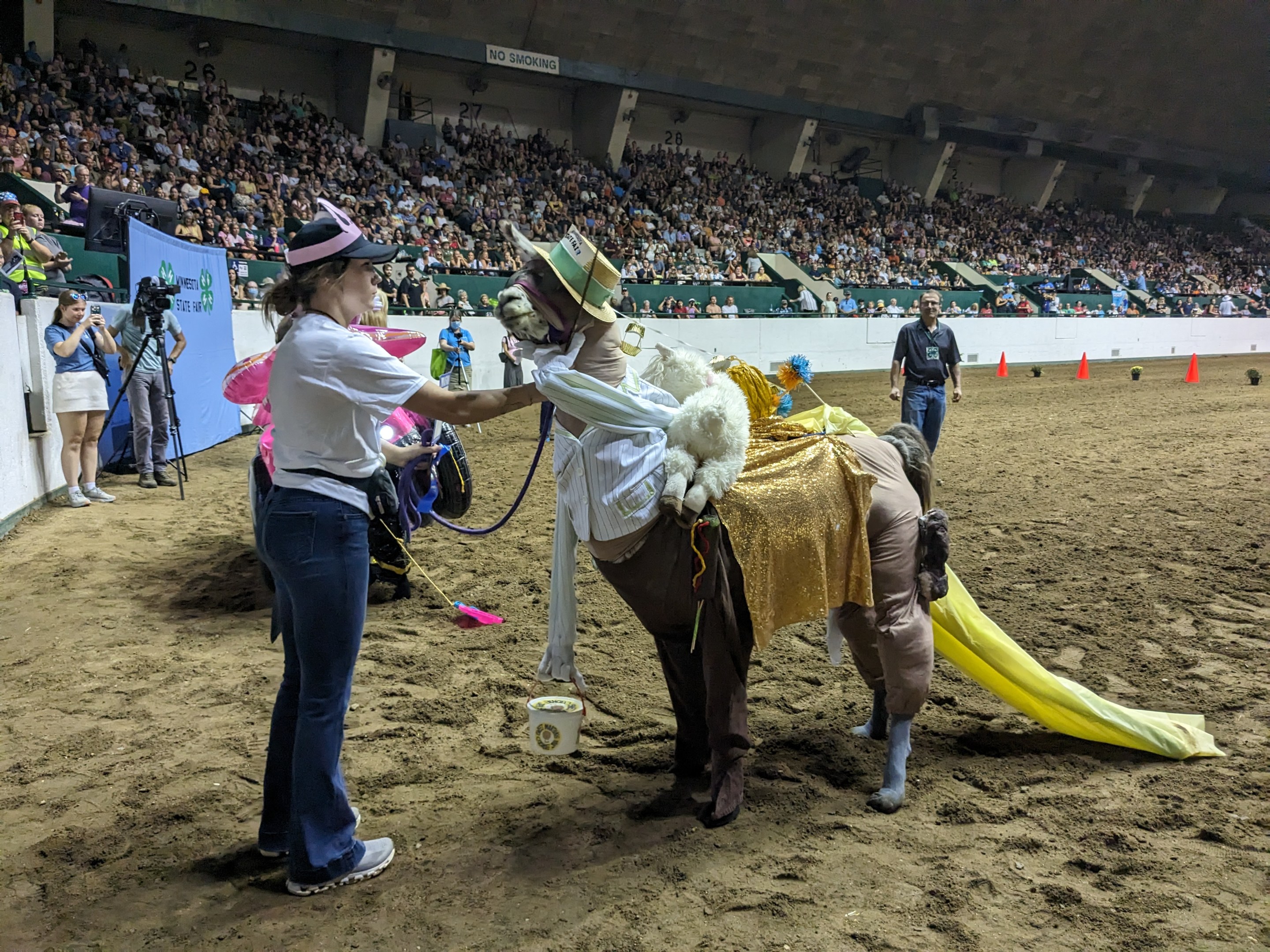Over the course of 15 years, the 4-H llama-alpaca costume contest has become one of the most popular attractions at the Minnesota State Fair. Part of 4-H’s three-day State Fair llama-alpaca experience, the contest is teens, tweens, and their respective llamas or alpacas wearing costumes. The llamas and alpacas also compete on an obstacle course on the following day. That’s it, and that’s enough. I am a regular costume-contest attendee, but 2023 was the first year I attended both events. Here is my llama-alpaca experience.
Wednesday, August 31
4:30 p.m.: Hours into my third visit to this year’s State Fair, I abandoned my friends for the exhibitor orientation in Compeer Arena. The word “arena” is maybe a little grandiose, here. Compeer is a corrugated structure with a dirt floor, some stables, and bleachers. When I entered, 61 students in various 4-H shirts were spread out on the bleacher’s front rows. The youngest had just finished sixth grade; the oldest were a year out of high school. The majority were girls. Adult volunteers, staff, and parents milled about, many in llama- or alpaca-themed shirts. I also wore a llama shirt, black with a white llama. As orientation ended, a 4-H leader told students to be ready for questions from the public such as, “Does your llama spit?”
5:06 p.m.: In a section of the Horse Barn housing the llamas and alpacas, I was joined by Andrew, a friend visiting from New York, who had agreed to take some photos for this story. A 4-H leader introduced me to several teens who were not participating in the costume contest. The obstacle courses and showmanship events on Thursday and Friday were demonstration events for the 4-H Llama–Alpaca Project.
As a girl introduced me to her llama Manly Man, a woman ran up, hollering. “Manly Man!” she said. “This is my favorite llama. I’ve taken a picture with him every year since 2016!” After she posed for her 2023 photo, I learned that Manly Man’s No. 1 fan runs an Unofficial Minnesota State Fair Instagram account. She would go on to spend over 120 hours visiting the State Fair this year; the fair is 12 days long.
5:15 p.m.: I asked how llamas react when spat on by their fellow llamas. A student suggested that the spat-upon llama is briefly paralyzed. “Wait, the spit is like venom?” I asked, assuming I’d misunderstood. The exhibitor shrugged. “Something like that,” they said. This seemed extremely untrue, but I’d sort this out later.
5:19 p.m.: I found my group of friends at a stall talking to a kid and their mom. This is how I met Annie, who was competing in the intermediate division (sixth through eighth grade), the youngest 4-H group at the State Fair. Annie removed their llama Titan, an absolute unit, from his stall for us to meet. As I pet Titan, I asked if he had to be bribed with treats during training. Annie gave Titan a loving pat and laughed. “No, it’s easy to convince him. Because they’re just idiots. He’s a 400-pound idiot.” Titan stared ahead, perhaps daydreaming about eating grass while circus music played on a loop in his head.
After asking if we’d heard of Star Wars, Annie told us about their costume. The pair would compete as Baby Yoda accompanying Titan the Mandalorian. Genuinely excited to see it, we wished Annie luck and left.
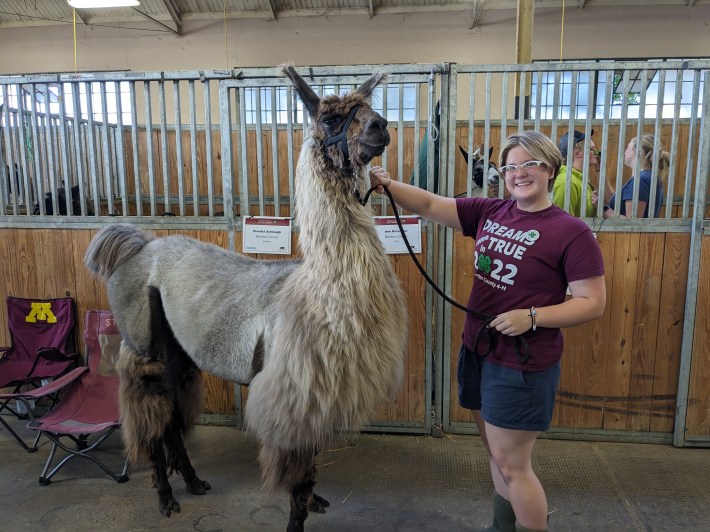
5:30 p.m.: After roaming around the barn, I realized that I hadn’t seen many alpacas yet. Some visual differences between llamas and alpacas: Llamas are bigger than alpacas. An alpaca’s ears are pointy, while a llama’s are banana-shaped. Llamas have long faces; alpacas’ are compact. Alpacas also have softer coats and fluffy hair on their head.
5:45 p.m.: Flanked by police on horseback, the five contestants in the advanced division (11th grade and up) lined up for the short parade from the horse barn to the coliseum.
5:50 p.m.: Andrew and I headed to Warner Coliseum, a 5,000-seat arena. At the peak of the costume contest, the arena will be approximately 75 percent full. Inside, we ran into Minnesota state auditor Julie Blaha, who is a friend of mine via the crop art community. Blaha, a regular costume-contest attendee, tagged along with us. She offered to take pictures so she could see the costumes up close. Andrew, New Yorker that he is, couldn’t believe that a statewide elected official was assisting me in what what we were doing.
6:10 p.m.: After brief remarks from various dignitaries, announcer Kristen Varas, seated next to the ring, introduces the judge. Harvey Pool, an older man in a cowboy hat and boots waved to the crowd. He has flown in from Georgia to judge the contests.
Scoring is based on cohesion between human and beast, and also on how challenging the costume is for the llama or alpaca to wear. The more it’s covered, the better, especially the head and legs. Does the costume make noises or have dangling objects that could distract the animal? That’s more points right there. Still, the well-being of the llama or alpaca is paramount.
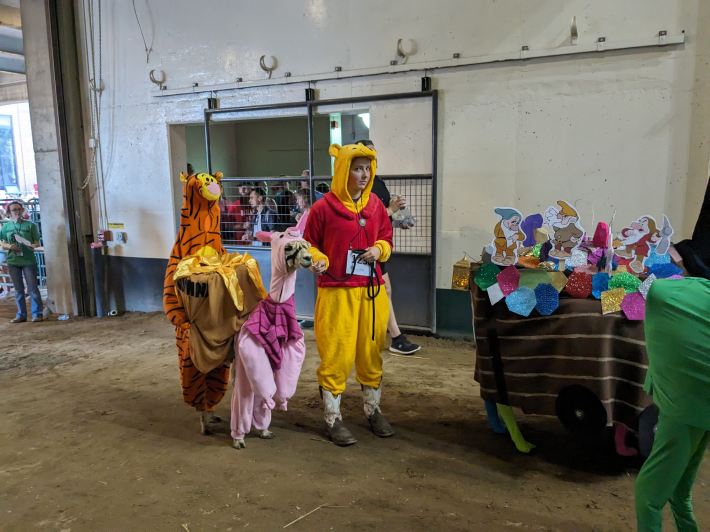
6:12 p.m.: A helmeted race car driver kicked off the advanced division. More accurately, a child dressed as a helmeted race car driver did. His small, leashed llama wore a cardboard muscle car with illuminated headlights. Fabric exhaust flames hung from each side of the car. Varas cheerfully announced each participant’s name, home county, llama or alpaca’s name, and names of the parents. As each exhibitor walked the ring, she read from a stack of narratives submitted by contestants that explained their costume and how it was made. She doesn’t see the narratives, some of which contained puns and song lyrics, until right before the show. A 4-H parent and alumna, Varas volunteered for the emcee gig six years ago and quickly became a fan favorite for her enthusiastic delivery. She is known for mixing in audience sing-a-longs and encouraging asides like “You nailed the color.”
6:15 p.m.: A Barbie led a llama dressed as Ken in a Barbie car. The car had working headlights. “Spoiler, I bet that llama’s toenails are pink,” Varas riffed. As far as I could tell, they were not. The auditor waved me over to interview Kristine Kolhoff, “Barbie’s” mom. Breathlessly, Kolhoff lists what went into the costume: inner tubes, vinyl, PVC piping, nine rolls of duct tape, 40 hours of labor. She recounted a harrowing tale from a county fair in which the costume, sans llama, melted in the sun and then had to be reconstructed.
6:30 p.m.: In line for judging, a Minnesota State Fair-themed llama with a straw boater on its head demanded its handler take it on a short walk. Pool told the audience, in a dense Southern drawl, that he’d “never seen a crowd so big at any llama show in the country.” The audience roared. Barbie won first place. A Grinch with an alpaca dressed like the Grinch’s dog Max, complete with a stack of presents on its back, claimed a separate award from the Minnesota Textile Center, given in each division for the “best use of textile to tell a story.” While exiting the arena, that alpaca freaked out and started kicking. Adult volunteers cleared a wider path, and the Grinch safely escorted “Max” out.
6:35 p.m.: A Phantom (of the Opera) in the senior division (ninth and 10th grade) waited with at least 20 other competitors to enter the arena. Her llama was dressed as a chandelier, covered in black fabric and silver pool noodles. “The Music of the Night” played from a speaker hidden somewhere on the llama’s costume.
6:40 p.m.: Another Barbie costume, this one with a Ken mannequin in the back seat of the llama car. When Ken flopped forward, an audience member told a seatmate, “It looks kinda like JFK.”
“We have some Minions,” Varas said about another competitor, after realizing a narrative was missing. She continued describing their outfits and the audience gave a supportive cheer. Varas found the kid’s name and apologized as the Minions joined the judging line.
6:47 p.m.: Winnie the Pooh appeared with an alpaca whose front half was dressed like Piglet and whose back half was dressed like Tigger carrying a pot of honey. As they walked, it looked like Tigger was bouncing behind Piglet. The audience ate it up. Pool awarded “the tiger” third place and said he didn’t “know how she got that guy to walk behind … holdin’ that bucket of money.” While not officially part of the judging criteria, he also acknowledged that this costume was a crowd favorite.
7:04 p.m.: Finally, the intermediate division. This division was just as large as the previous one. A Dunkin Donuts employee led a giant donut into the ring; had we been in Massachusetts, the competition would have ended there. An astronaut walked in with a llama dressed like space, like space itself as a concept, complete with string lights for stars. Space Llama suddenly stopped in front of the 4-H backdrop used to photograph champions and, with a smug look on its face, relieved itself. Outstanding comedic timing, Space Llama.
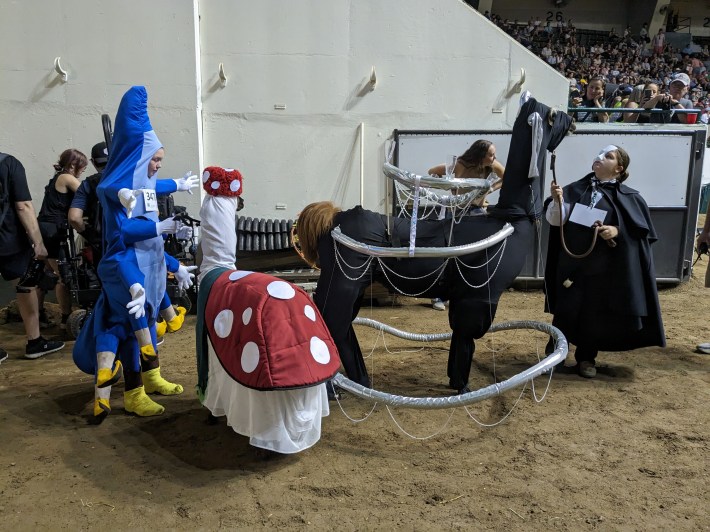
7:14 p.m.: Annie and Titan. Titan wore a cardboard helmet painted silver, with cardboard and cloth armor accented with a string of lights. Annie’s Grogu (Baby Yoda) stood in a silver pod, made from a hula hoop and bisected beach ball covered in fabric. My biases aside, the costume was magnificent. I joined the audience in cheering loudly. The textile judges agreed, and Annie and Titan received the Textile Center award.
7:20 p.m.: A double rainbow. A child and her llama each wore a rainbow and carried an umbrella. The llama’s umbrella sat atop its head. I was well acquainted with the judging standards by then, and knew they’d win. Immediately after Pool finished judging, rainbow llama kicked off its costume. “Y’all know you have to look quick to see a double rainbow,” Pool said as he awarded them first place.
7:30 p.m.: The show was over. I met up with friends, many of which had never previously seen the contest. They loved it, they told me, but were also plainly struggling to process what they’d just witnessed.
11:30 p.m.: I realized, late in the game, that the “llama” on my shirt was an alpaca. I felt terrible for doing accidental racism to alpacas.
Thursday, September 1
5:15 p.m.: With two friends in tow, I met Kristen Varas at Compeer, home of the obstacle courses.
I got right to business: “Llamas or alpacas?”
Varas laughed and said they’re both great, then expressed a preference for the llamas she grew up with. At 6-foot-2, she overshadows the comparatively slight alpacas. Also, she finds llamas easier to train. The previous day, Varas had run afoul of an alpaca owner who overheard her “diplomatically” answering the same question. While llama and alpaca people are “polarized,” she explained that some alpaca farms use a single guard llama to herd and protect the alpacas. I wondered if alpacas consider llamas to be older siblings or the cops.
Varas said we could find exhibitors socializing outside the building at a covered “poop pile,” where their llamas and alpacas did their business. They prefer to poop in communal piles. Once a llama or alpaca goes to the bathroom during a show, several will. Varas found it especially funny when animals in pants go during shows. I agreed; the memory of a llama in bell bottoms and a wig taking a dump has been seared into my brain for years.
On the issue of llama spit, she explained that the llamas and alpacas doing the spitting were exhausted, and throwing up cud in anger. I’d be tired too if someone made me so mad I projectile-vomited! Later, I learn that llamas and alpacas will sometimes spit warning shots into the air.

6:00 p.m.: The kids are walked through the obstacle and public relations courses, which will run simultaneously. The obstacle course replicates things a llama or alpaca might encounter in a pasture; the public relations course simulates public interactions.
6:30 p.m.: State Fair dinner break! We consumed: brie soaked in red wine, fried, and sprinkled with powdered sugar; Somali iced tea; tiramisu-flavored beer; plantains; a corn dog; pork chop on a stick; fried pickles; a “Hot Dago" sandwich on a stick (yes, that’s the actual name).
8:00 p.m.: Back at the arena. Each kid and their llama or alpaca were announced upon entering and exiting the courses. The murmur of the crowd was interrupted by repeated applause. Harvey Pool observed one course, while a second judge, David Ruckman from Ohio, watched the other.
We watched as animals on the public relations course were led through a yard gate, around poles, and through a rack of pool noodles that were meant to replicate a crowd brushing against their legs. Llamas and alpacas quickly hopped in and out of a kiddie pool filled with plastic balls, which they found annoying. Handlers stopped at a lawn chair where a woman stood and gave each animal a single pet down its back and sat down. A large teddy bear, seated on a chair, piqued the curiosity of several animals, which seemed to be its purpose. More obstacles, and then the llama/alpaca was loaded in and out of a trailer before exiting the course. This was the easier of the two challenges.
On the obstacle course, a small llama named Chocolate Chip defied his sixth-grade charge and treated the course at his leisure. Time wasn’t a factor, and Chocolate Chip knew it. At one obstacle the handler, who was unable to touch the animal per the rules, tried everything to persuade the llama to move. The boy closed his eyes, tipped his head back, and let out an exasperated sigh. Pool offered quiet encouragement as Chocolate Chip continued to stare at nothing. When they completed the course, the audience enthusiastically applauded the kid’s perseverance in the face of a powerfully indifferent llama.
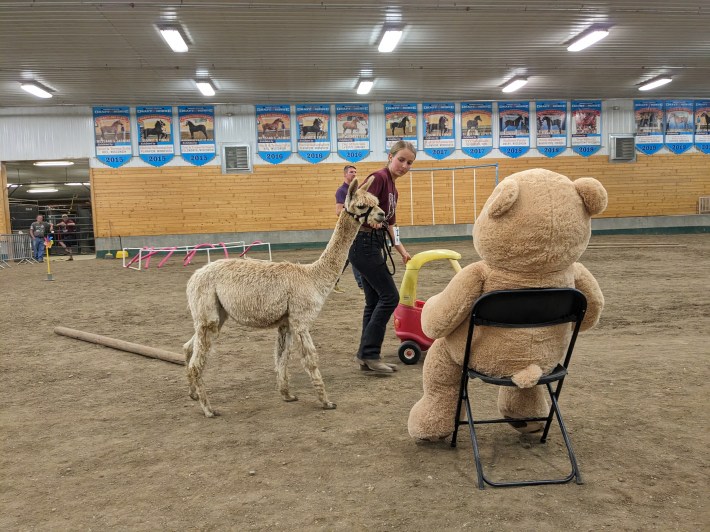
The course itself featured both a step and a small bridge. For many of the Midwestern camelids, this was a bridge both too high and too far. Titan took one look and simply strolled past, seemingly content to move on to the next test. I asked Abby Spence, the 4-H project development committee member/alumna seated next me, if she thought mountain-based alpacas and llamas would laugh at their scared cousins. She chuckled.
Like everyone in the 4-H Llama-Alpaca Project I’ve ever met, Spence was happy to answer all our questions. She’s a rare alpaca person in this scene, and her family has an alpaca farm in western Minnesota. She thinks that skittish alpacas are merely a little harder to train. Since many 4-H participants don’t live on farms, Spence’s farm loans alpacas to 4-H kids in exchange for them helping to care for the animal on the farm. While not all farms forego a leasing fee, many do.
“Could I rent one?” I asked, entertaining the idea of entering the State Fair’s llama-alpaca obstacle course open to adults. I should acknowledge here that this is not the first time I’ve inquired about joining the llama/alpaca community. Before the fair, on a call with State Llama Committee Co-President Lyn Meany, I learned that kids sit and read with the animals to get them used to the sound of their voices. Immediately, I wanted to workshop some of my writing in front of a bored llama; it seemed like good practice.
Spence said she and any of the other farmers present would probably at least let me visit a farm.
9:16 p.m.: Spence pointed across the ring. “That’s one of our alpacas. We cut their hair into mullets.” I watched as an adorable brown alpaca that looked like Danny McBride in Eastbound & Down hopped through a hoop.
10:05 p.m.: Awards. The kids were still energetic and giddy. Approximately 200 people remained in the stands, many of them parents. First and second place were awarded for each course in each age group. Everyone else received a blue or red ribbon based on performance.
10:30 p.m.: The various competitors returned to the barn and put their animals, who may or may not have known that they were just in a competition, to bed. Adults wearily stood up. As I prepared to leave, someone asked if I would be back for the showmanship competition early the next day. I had to tell them that I would not.
“That was fun!” I said to my wide-eyed friends as we emerged from the arena. As we made our way toward the exit, Duran Duran played on the main stage.
During the costume contest, Pool said “a lot of people say we take our kids and show livestock, but we take our llamas to show off our kids.” Every adult I encountered, from parents to volunteers to staff, repeated some version of this sentiment. But to me, the llama-alpaca project is not just about the children. It showcases the commitment that the adults, many of them volunteers, have for educating the next generation, and making sure they have fun. It also shows off how well-behaved these llamas and alpacas are in the face of crowds, outfits, and physical challenges.
Additional thanks to Maddie Eaton, Lyn Meany, and Sharon Davis from 4-H; Andrew Goldston, Kat Jong, and Julie Blaha for photo assistance. And a special thank you to the entire Minnesota llama-alpaca project community, especially those I spoke to and was unable to fit into the article.
